Business Finance Assignment: Capital Structure and Valuation
VerifiedAdded on 2020/04/21
|12
|1687
|174
Homework Assignment
AI Summary
This Business Finance assignment solution provides a comprehensive analysis of various financial concepts. The assignment covers topics such as managerial flexibility in investment decisions, dividend payment versus share repurchase, and the use of debt in capital structure. It includes calculations and explanations related to share valuation, earnings per share (EPS), and the impact of financial decisions on shareholder wealth. Furthermore, the document explores future contracts, bond futures, and stock index futures, offering insights into hedging and arbitrage opportunities. It also examines share issues, subscription prices, and their implications for company capital. Finally, the assignment delves into short-term and long-term debt securities, analyzing their characteristics and impact on a company's financial health. The assignment is supported by relevant references and bibliographies.

Running head: BUSINESS FINANCE
Business Finance
Name of the Student:
Name of the University:
Author’s Note:
Course ID:
Business Finance
Name of the Student:
Name of the University:
Author’s Note:
Course ID:
Paraphrase This Document
Need a fresh take? Get an instant paraphrase of this document with our AI Paraphraser
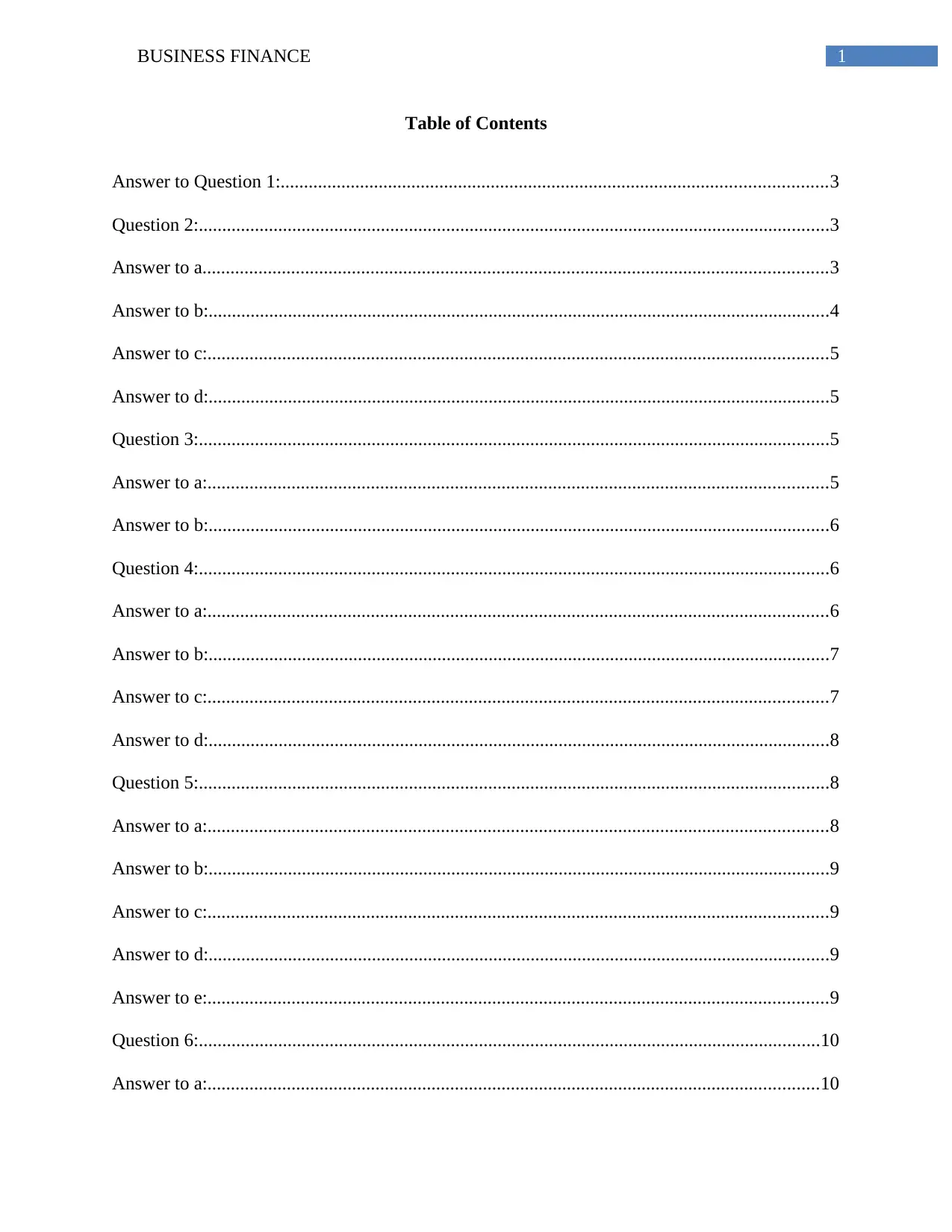
1BUSINESS FINANCE
Table of Contents
Answer to Question 1:.....................................................................................................................3
Question 2:.......................................................................................................................................3
Answer to a......................................................................................................................................3
Answer to b:.....................................................................................................................................4
Answer to c:.....................................................................................................................................5
Answer to d:.....................................................................................................................................5
Question 3:.......................................................................................................................................5
Answer to a:.....................................................................................................................................5
Answer to b:.....................................................................................................................................6
Question 4:.......................................................................................................................................6
Answer to a:.....................................................................................................................................6
Answer to b:.....................................................................................................................................7
Answer to c:.....................................................................................................................................7
Answer to d:.....................................................................................................................................8
Question 5:.......................................................................................................................................8
Answer to a:.....................................................................................................................................8
Answer to b:.....................................................................................................................................9
Answer to c:.....................................................................................................................................9
Answer to d:.....................................................................................................................................9
Answer to e:.....................................................................................................................................9
Question 6:.....................................................................................................................................10
Answer to a:...................................................................................................................................10
Table of Contents
Answer to Question 1:.....................................................................................................................3
Question 2:.......................................................................................................................................3
Answer to a......................................................................................................................................3
Answer to b:.....................................................................................................................................4
Answer to c:.....................................................................................................................................5
Answer to d:.....................................................................................................................................5
Question 3:.......................................................................................................................................5
Answer to a:.....................................................................................................................................5
Answer to b:.....................................................................................................................................6
Question 4:.......................................................................................................................................6
Answer to a:.....................................................................................................................................6
Answer to b:.....................................................................................................................................7
Answer to c:.....................................................................................................................................7
Answer to d:.....................................................................................................................................8
Question 5:.......................................................................................................................................8
Answer to a:.....................................................................................................................................8
Answer to b:.....................................................................................................................................9
Answer to c:.....................................................................................................................................9
Answer to d:.....................................................................................................................................9
Answer to e:.....................................................................................................................................9
Question 6:.....................................................................................................................................10
Answer to a:...................................................................................................................................10

2BUSINESS FINANCE
Answer to b:...................................................................................................................................10
Answer to c:...................................................................................................................................10
References and Bibliographies:.....................................................................................................12
Answer to b:...................................................................................................................................10
Answer to c:...................................................................................................................................10
References and Bibliographies:.....................................................................................................12
⊘ This is a preview!⊘
Do you want full access?
Subscribe today to unlock all pages.

Trusted by 1+ million students worldwide
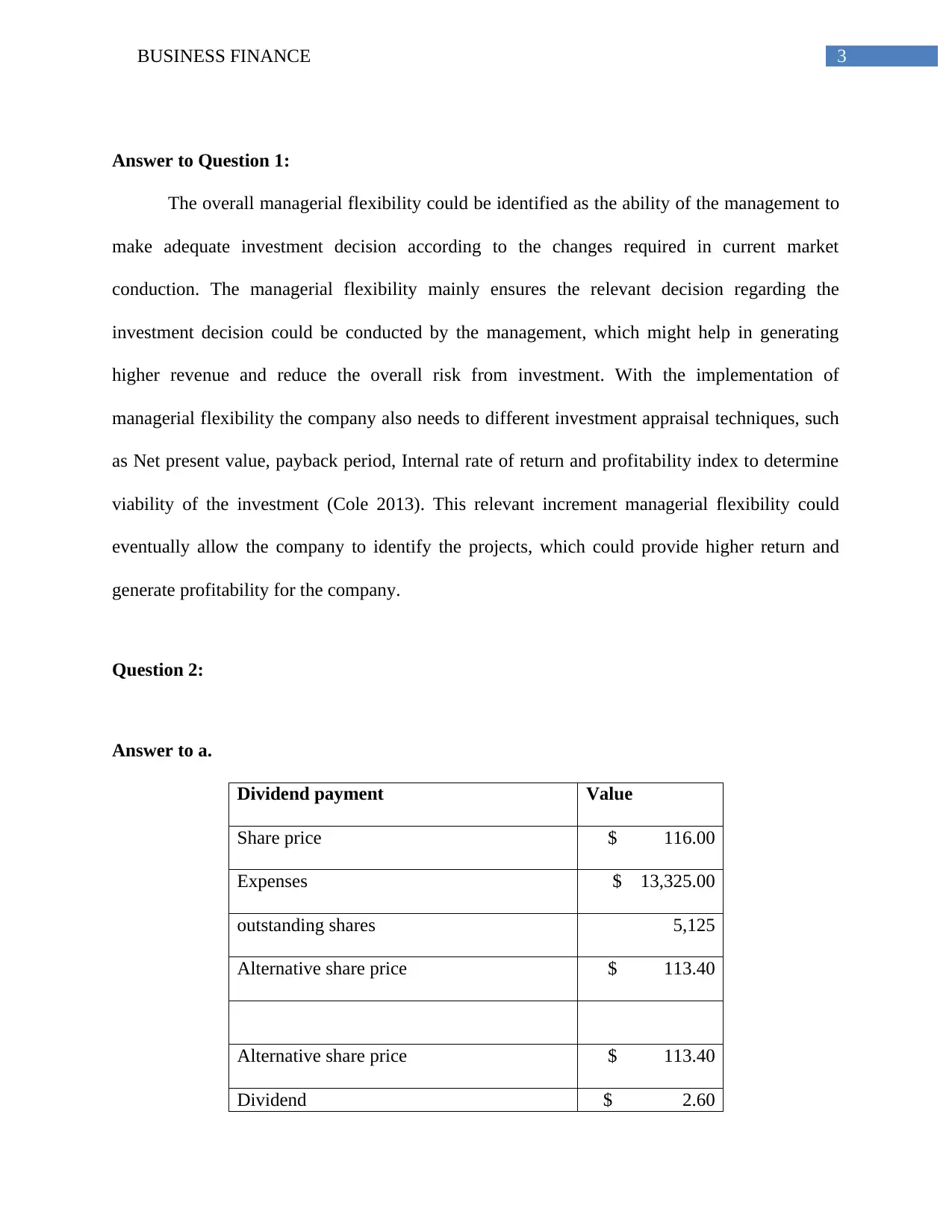
3BUSINESS FINANCE
Answer to Question 1:
The overall managerial flexibility could be identified as the ability of the management to
make adequate investment decision according to the changes required in current market
conduction. The managerial flexibility mainly ensures the relevant decision regarding the
investment decision could be conducted by the management, which might help in generating
higher revenue and reduce the overall risk from investment. With the implementation of
managerial flexibility the company also needs to different investment appraisal techniques, such
as Net present value, payback period, Internal rate of return and profitability index to determine
viability of the investment (Cole 2013). This relevant increment managerial flexibility could
eventually allow the company to identify the projects, which could provide higher return and
generate profitability for the company.
Question 2:
Answer to a.
Dividend payment Value
Share price $ 116.00
Expenses $ 13,325.00
outstanding shares 5,125
Alternative share price $ 113.40
Alternative share price $ 113.40
Dividend $ 2.60
Answer to Question 1:
The overall managerial flexibility could be identified as the ability of the management to
make adequate investment decision according to the changes required in current market
conduction. The managerial flexibility mainly ensures the relevant decision regarding the
investment decision could be conducted by the management, which might help in generating
higher revenue and reduce the overall risk from investment. With the implementation of
managerial flexibility the company also needs to different investment appraisal techniques, such
as Net present value, payback period, Internal rate of return and profitability index to determine
viability of the investment (Cole 2013). This relevant increment managerial flexibility could
eventually allow the company to identify the projects, which could provide higher return and
generate profitability for the company.
Question 2:
Answer to a.
Dividend payment Value
Share price $ 116.00
Expenses $ 13,325.00
outstanding shares 5,125
Alternative share price $ 113.40
Alternative share price $ 113.40
Dividend $ 2.60
Paraphrase This Document
Need a fresh take? Get an instant paraphrase of this document with our AI Paraphraser
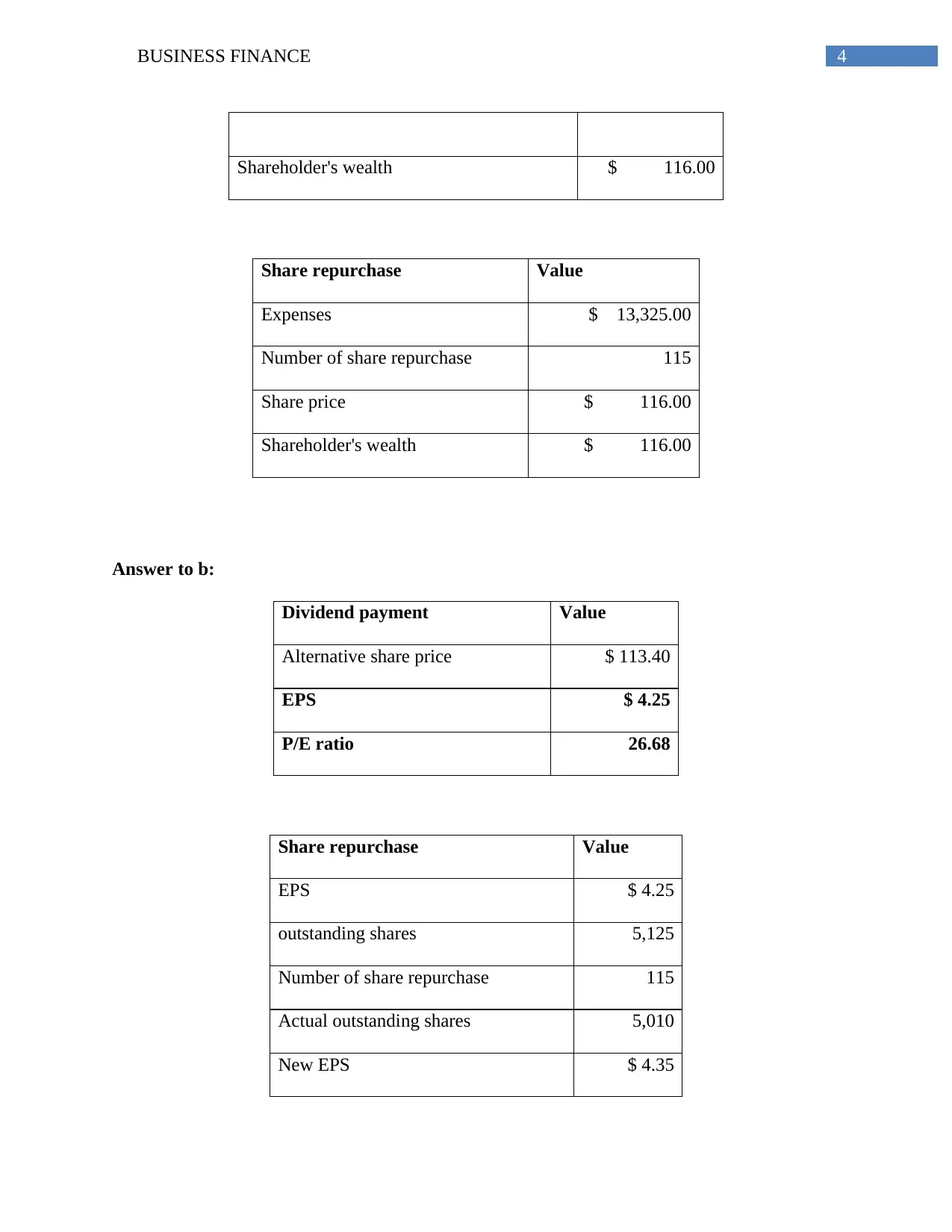
4BUSINESS FINANCE
Shareholder's wealth $ 116.00
Share repurchase Value
Expenses $ 13,325.00
Number of share repurchase 115
Share price $ 116.00
Shareholder's wealth $ 116.00
Answer to b:
Dividend payment Value
Alternative share price $ 113.40
EPS $ 4.25
P/E ratio 26.68
Share repurchase Value
EPS $ 4.25
outstanding shares 5,125
Number of share repurchase 115
Actual outstanding shares 5,010
New EPS $ 4.35
Shareholder's wealth $ 116.00
Share repurchase Value
Expenses $ 13,325.00
Number of share repurchase 115
Share price $ 116.00
Shareholder's wealth $ 116.00
Answer to b:
Dividend payment Value
Alternative share price $ 113.40
EPS $ 4.25
P/E ratio 26.68
Share repurchase Value
EPS $ 4.25
outstanding shares 5,125
Number of share repurchase 115
Actual outstanding shares 5,010
New EPS $ 4.35
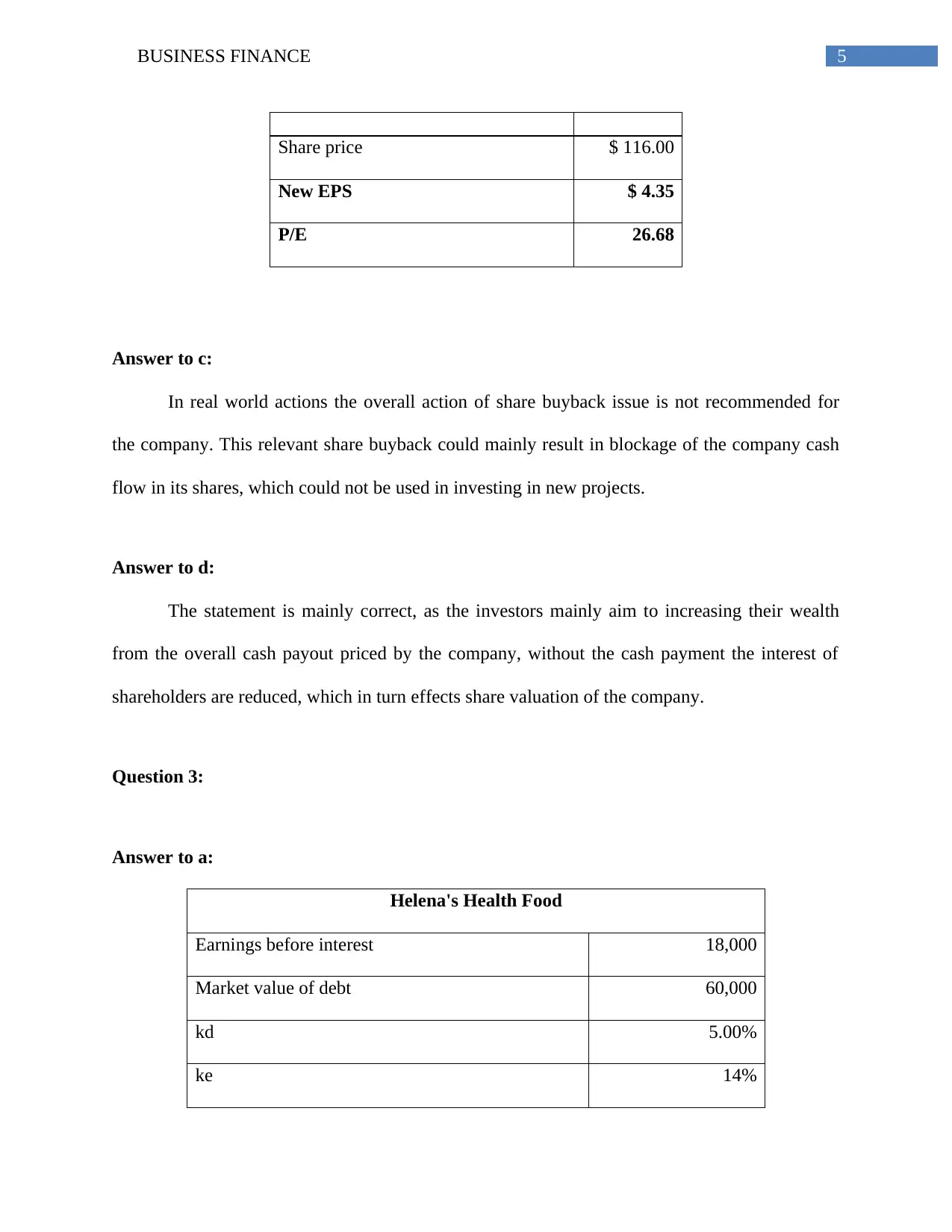
5BUSINESS FINANCE
Share price $ 116.00
New EPS $ 4.35
P/E 26.68
Answer to c:
In real world actions the overall action of share buyback issue is not recommended for
the company. This relevant share buyback could mainly result in blockage of the company cash
flow in its shares, which could not be used in investing in new projects.
Answer to d:
The statement is mainly correct, as the investors mainly aim to increasing their wealth
from the overall cash payout priced by the company, without the cash payment the interest of
shareholders are reduced, which in turn effects share valuation of the company.
Question 3:
Answer to a:
Helena's Health Food
Earnings before interest 18,000
Market value of debt 60,000
kd 5.00%
ke 14%
Share price $ 116.00
New EPS $ 4.35
P/E 26.68
Answer to c:
In real world actions the overall action of share buyback issue is not recommended for
the company. This relevant share buyback could mainly result in blockage of the company cash
flow in its shares, which could not be used in investing in new projects.
Answer to d:
The statement is mainly correct, as the investors mainly aim to increasing their wealth
from the overall cash payout priced by the company, without the cash payment the interest of
shareholders are reduced, which in turn effects share valuation of the company.
Question 3:
Answer to a:
Helena's Health Food
Earnings before interest 18,000
Market value of debt 60,000
kd 5.00%
ke 14%
⊘ This is a preview!⊘
Do you want full access?
Subscribe today to unlock all pages.

Trusted by 1+ million students worldwide

6BUSINESS FINANCE
Market value of equity 110,000
Actual Total market value 170,000
Equilibrium value 150,000
WACC 6.71%
Investment 2,200.00
Expected increment in income 147.53
Total amount received 2,347.53
Answer to b:
The main advantages of the company for using debt in capital structure could directly
reduce tax payment. This could eventually allow the organisation to retain the required level of
retained income, which could help in supporting future expansion and activities of the company.
The major limitation is the overall reduction in profit and increment in insolvency changes of the
company. This could eventually increase problems for the company to sustain the required level
of activity due to cash shortage (Hannafey and Vitulano 2013).
Question 4:
Answer to a:
Particulars Value
90 day future contract 94.78
Close out position value 96.42
Face value 1,000,000
Market value of equity 110,000
Actual Total market value 170,000
Equilibrium value 150,000
WACC 6.71%
Investment 2,200.00
Expected increment in income 147.53
Total amount received 2,347.53
Answer to b:
The main advantages of the company for using debt in capital structure could directly
reduce tax payment. This could eventually allow the organisation to retain the required level of
retained income, which could help in supporting future expansion and activities of the company.
The major limitation is the overall reduction in profit and increment in insolvency changes of the
company. This could eventually increase problems for the company to sustain the required level
of activity due to cash shortage (Hannafey and Vitulano 2013).
Question 4:
Answer to a:
Particulars Value
90 day future contract 94.78
Close out position value 96.42
Face value 1,000,000
Paraphrase This Document
Need a fresh take? Get an instant paraphrase of this document with our AI Paraphraser
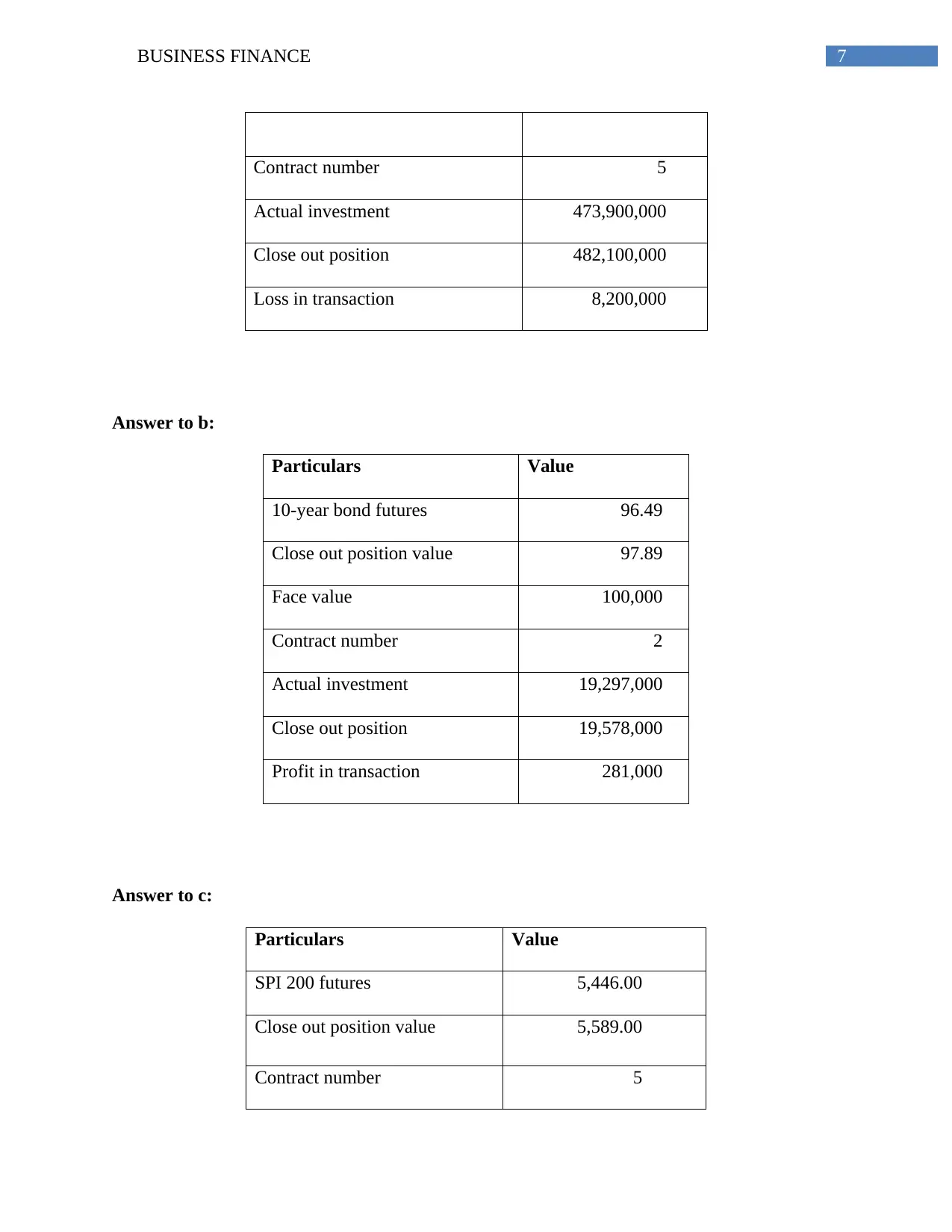
7BUSINESS FINANCE
Contract number 5
Actual investment 473,900,000
Close out position 482,100,000
Loss in transaction 8,200,000
Answer to b:
Particulars Value
10-year bond futures 96.49
Close out position value 97.89
Face value 100,000
Contract number 2
Actual investment 19,297,000
Close out position 19,578,000
Profit in transaction 281,000
Answer to c:
Particulars Value
SPI 200 futures 5,446.00
Close out position value 5,589.00
Contract number 5
Contract number 5
Actual investment 473,900,000
Close out position 482,100,000
Loss in transaction 8,200,000
Answer to b:
Particulars Value
10-year bond futures 96.49
Close out position value 97.89
Face value 100,000
Contract number 2
Actual investment 19,297,000
Close out position 19,578,000
Profit in transaction 281,000
Answer to c:
Particulars Value
SPI 200 futures 5,446.00
Close out position value 5,589.00
Contract number 5
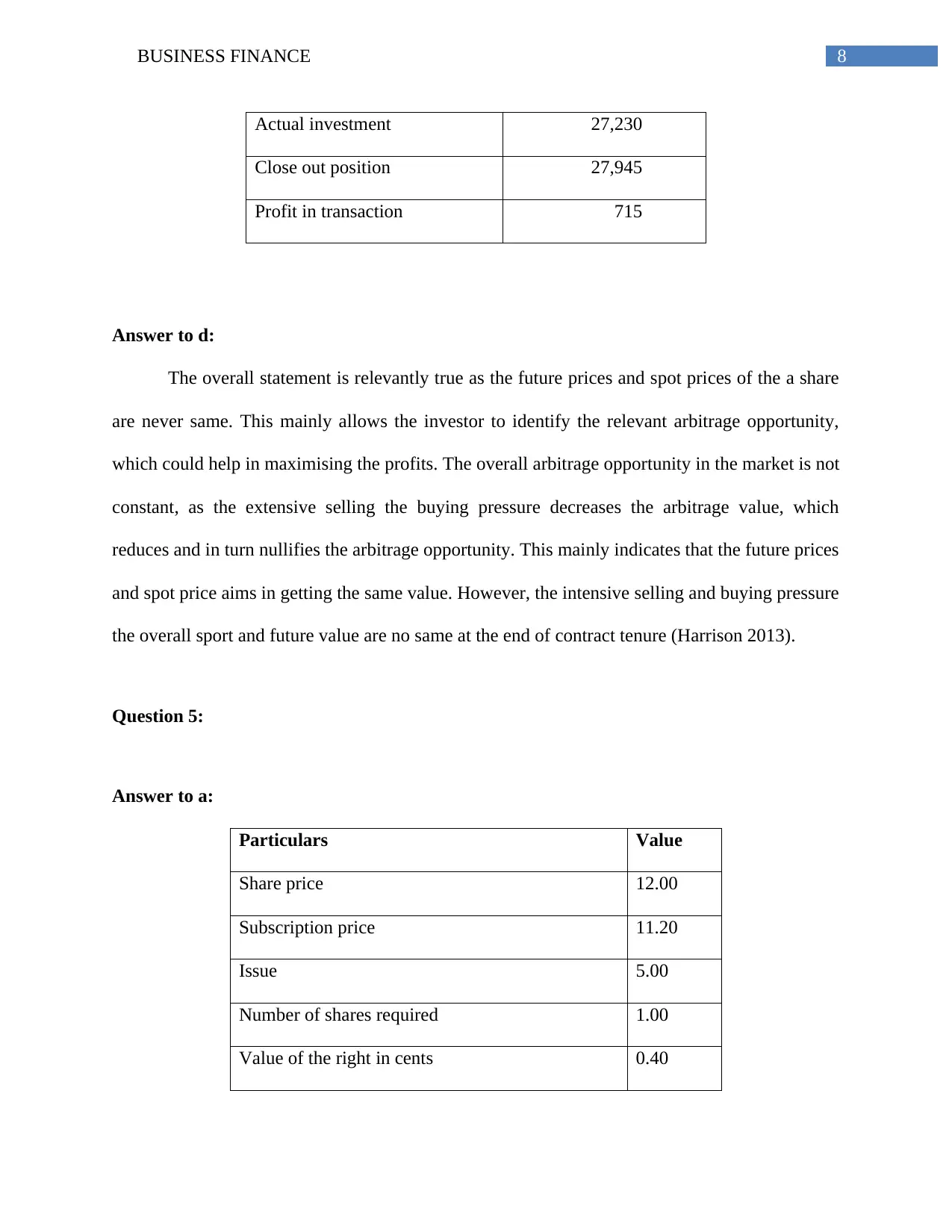
8BUSINESS FINANCE
Actual investment 27,230
Close out position 27,945
Profit in transaction 715
Answer to d:
The overall statement is relevantly true as the future prices and spot prices of the a share
are never same. This mainly allows the investor to identify the relevant arbitrage opportunity,
which could help in maximising the profits. The overall arbitrage opportunity in the market is not
constant, as the extensive selling the buying pressure decreases the arbitrage value, which
reduces and in turn nullifies the arbitrage opportunity. This mainly indicates that the future prices
and spot price aims in getting the same value. However, the intensive selling and buying pressure
the overall sport and future value are no same at the end of contract tenure (Harrison 2013).
Question 5:
Answer to a:
Particulars Value
Share price 12.00
Subscription price 11.20
Issue 5.00
Number of shares required 1.00
Value of the right in cents 0.40
Actual investment 27,230
Close out position 27,945
Profit in transaction 715
Answer to d:
The overall statement is relevantly true as the future prices and spot prices of the a share
are never same. This mainly allows the investor to identify the relevant arbitrage opportunity,
which could help in maximising the profits. The overall arbitrage opportunity in the market is not
constant, as the extensive selling the buying pressure decreases the arbitrage value, which
reduces and in turn nullifies the arbitrage opportunity. This mainly indicates that the future prices
and spot price aims in getting the same value. However, the intensive selling and buying pressure
the overall sport and future value are no same at the end of contract tenure (Harrison 2013).
Question 5:
Answer to a:
Particulars Value
Share price 12.00
Subscription price 11.20
Issue 5.00
Number of shares required 1.00
Value of the right in cents 0.40
⊘ This is a preview!⊘
Do you want full access?
Subscribe today to unlock all pages.

Trusted by 1+ million students worldwide

9BUSINESS FINANCE
Answer to b:
Particulars Value
Share price 12.00
Subscription price 11.20
Issue 5.00
Value of introduced shares 56.00
Market value of 6 shares 68.00
Therefore theoretical ex-right share value 13.60
Answer to c:
The maximum possible subscription price could be less than actual market share price of
the company. This could eventually help in attracting more customers.
Answer to d:
This minimum subscription price could be greater than zero, until the actual market share
price of the company.
Answer to e:
From the overall perspective of company the share issue mainly allow the organisation to
gather the relevant capital that could help in supporting their future endeavours. However, the
major limitation for the company is after share issue is the decline in its share value. This is
mainly due the increase volume and supply of shares, which could in turn reduce its value
amount potential investors (Kennickell, Kwast and Pogach 2016).
Answer to b:
Particulars Value
Share price 12.00
Subscription price 11.20
Issue 5.00
Value of introduced shares 56.00
Market value of 6 shares 68.00
Therefore theoretical ex-right share value 13.60
Answer to c:
The maximum possible subscription price could be less than actual market share price of
the company. This could eventually help in attracting more customers.
Answer to d:
This minimum subscription price could be greater than zero, until the actual market share
price of the company.
Answer to e:
From the overall perspective of company the share issue mainly allow the organisation to
gather the relevant capital that could help in supporting their future endeavours. However, the
major limitation for the company is after share issue is the decline in its share value. This is
mainly due the increase volume and supply of shares, which could in turn reduce its value
amount potential investors (Kennickell, Kwast and Pogach 2016).
Paraphrase This Document
Need a fresh take? Get an instant paraphrase of this document with our AI Paraphraser
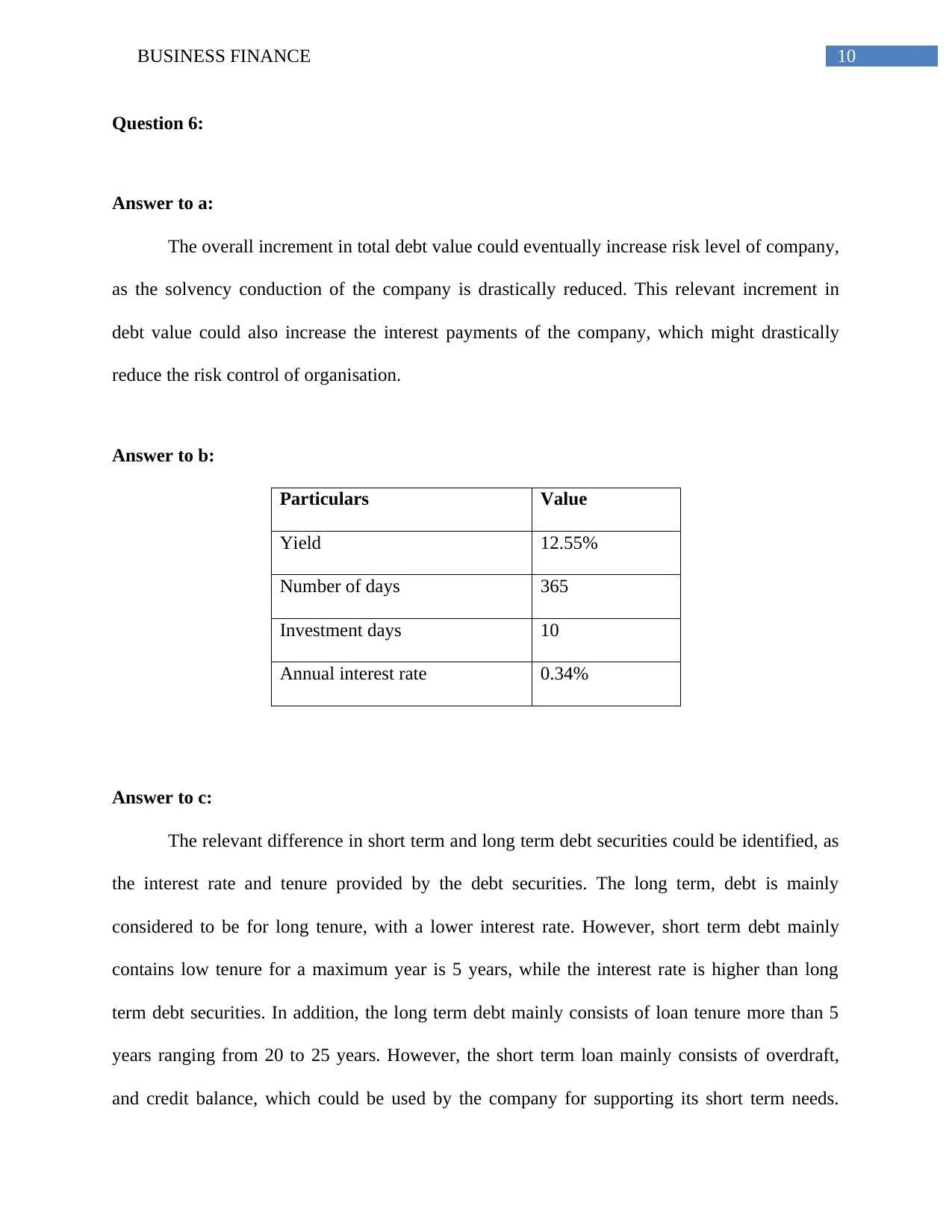
10BUSINESS FINANCE
Question 6:
Answer to a:
The overall increment in total debt value could eventually increase risk level of company,
as the solvency conduction of the company is drastically reduced. This relevant increment in
debt value could also increase the interest payments of the company, which might drastically
reduce the risk control of organisation.
Answer to b:
Particulars Value
Yield 12.55%
Number of days 365
Investment days 10
Annual interest rate 0.34%
Answer to c:
The relevant difference in short term and long term debt securities could be identified, as
the interest rate and tenure provided by the debt securities. The long term, debt is mainly
considered to be for long tenure, with a lower interest rate. However, short term debt mainly
contains low tenure for a maximum year is 5 years, while the interest rate is higher than long
term debt securities. In addition, the long term debt mainly consists of loan tenure more than 5
years ranging from 20 to 25 years. However, the short term loan mainly consists of overdraft,
and credit balance, which could be used by the company for supporting its short term needs.
Question 6:
Answer to a:
The overall increment in total debt value could eventually increase risk level of company,
as the solvency conduction of the company is drastically reduced. This relevant increment in
debt value could also increase the interest payments of the company, which might drastically
reduce the risk control of organisation.
Answer to b:
Particulars Value
Yield 12.55%
Number of days 365
Investment days 10
Annual interest rate 0.34%
Answer to c:
The relevant difference in short term and long term debt securities could be identified, as
the interest rate and tenure provided by the debt securities. The long term, debt is mainly
considered to be for long tenure, with a lower interest rate. However, short term debt mainly
contains low tenure for a maximum year is 5 years, while the interest rate is higher than long
term debt securities. In addition, the long term debt mainly consists of loan tenure more than 5
years ranging from 20 to 25 years. However, the short term loan mainly consists of overdraft,
and credit balance, which could be used by the company for supporting its short term needs.
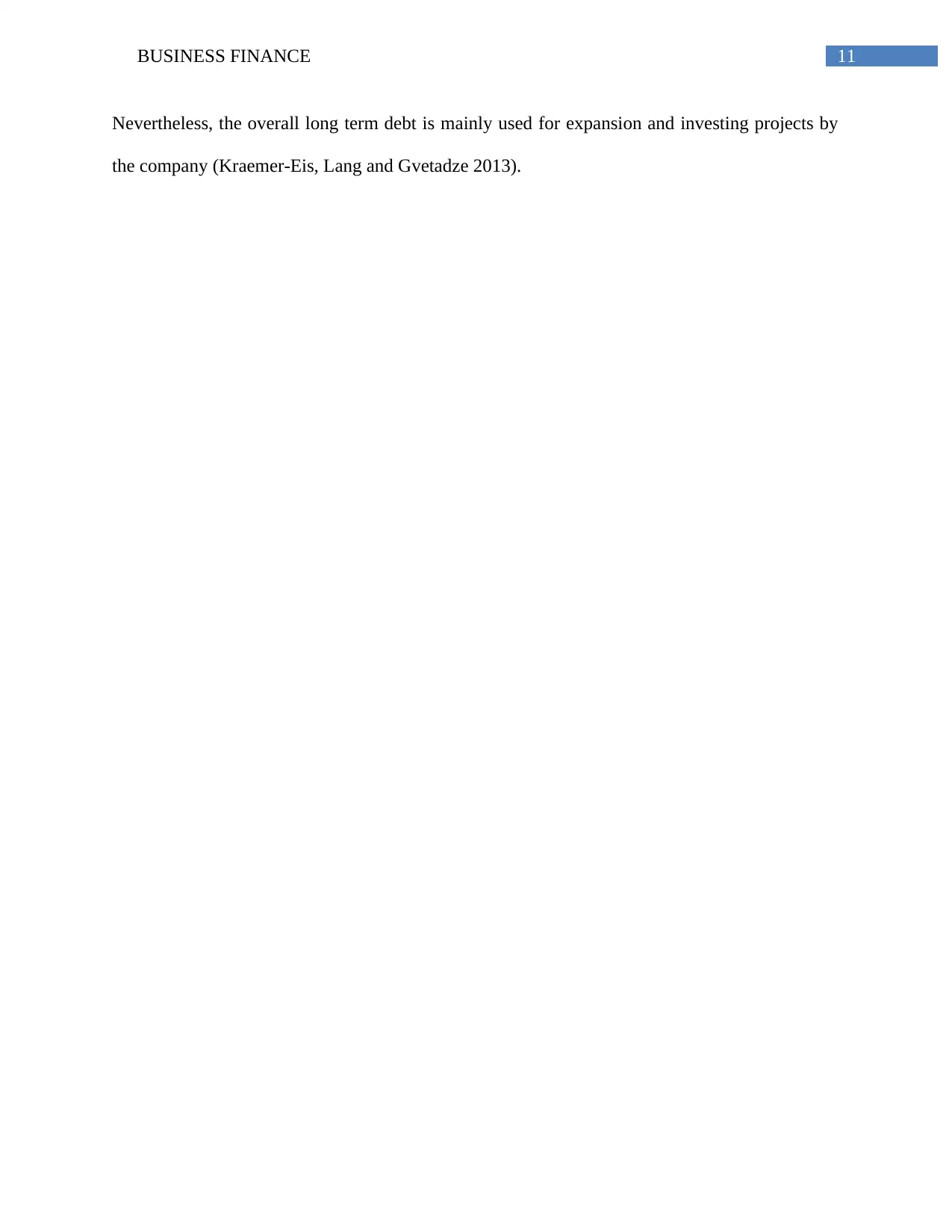
11BUSINESS FINANCE
Nevertheless, the overall long term debt is mainly used for expansion and investing projects by
the company (Kraemer-Eis, Lang and Gvetadze 2013).
Nevertheless, the overall long term debt is mainly used for expansion and investing projects by
the company (Kraemer-Eis, Lang and Gvetadze 2013).
⊘ This is a preview!⊘
Do you want full access?
Subscribe today to unlock all pages.

Trusted by 1+ million students worldwide
1 out of 12
Related Documents
Your All-in-One AI-Powered Toolkit for Academic Success.
+13062052269
info@desklib.com
Available 24*7 on WhatsApp / Email
![[object Object]](/_next/static/media/star-bottom.7253800d.svg)
Unlock your academic potential
Copyright © 2020–2025 A2Z Services. All Rights Reserved. Developed and managed by ZUCOL.

![Corporate Finance Assignment - [University Name], [Course Name]](/_next/image/?url=https%3A%2F%2Fdesklib.com%2Fmedia%2Fimages%2Fuo%2F094009c5b53d4253926258a7330aca34.jpg&w=256&q=75)



